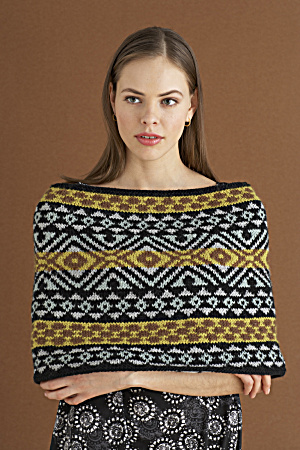 |
| These tips will come in especially handy when doing a stranded knitting project like this Fair Isle Capelet! You can see the pattern here. |
Once in a while I will search the social media universe to find out what yarncrafting techniques our customers could use help with. During my search I came across this suggestion on Twitter:
Kelly Black @ShortysSutures: Best ways to join yarn when knitting would be helpful. I don’t use a lot of wool, felted join is my fave but not always an option.
I thought this would be a great idea for a blog post and wanted to include tips for crocheters as well. My personal preference when joining yarn for knit and crochet is just to pick up the new strand if yarn. I like to do it this way because I don’t have to wait until I get to the end of a row and it’s optimal for when I am working in the round. Now the question is, “What do I do with those yarn tails and how do I keep my tension even?”. Well there are a couple tricks:
For Knitting: Hold the old and new strands of yarn together for a few stitches (only working from the new one), to help keep your tension even. The two stitches near where you joined the yarn are still going to look loose, but don’t worry we will fix that later. After you have worked a couple more rows use the duplicate stitch to weave in the ends on the wrong side. The duplicate stitch is often used for embroidery but is also great for finishing for a few reasons:
- It will help to tighten up those loose loops.
- It will disappear into the rest of the work to become nearly invisible later.
- It will stretch with the work so you don’t lose any elasticity
For Crocheting: We have a nice tutorial here for crocheting over your ends. I really like this method because you are getting some of your finishing done as you crochet to minimize your work later.
Other joining options that you can use are the Felted Join (which can only be done with animal hair fibers), which you can see a tutorial for here, and the Russian Join, which you can see a tutorial for here. As you experiment in your yarncrafting life you will find the method that you are most comfortable with, it’s totally up to you. If you need any further info we have another post here, with plenty of helpful tips.
Feel free to let me know if there are any other techniques you are struggling with and I will be glad to help. Happy crafting everyone!
You must be <a href="https://blog.lionbrand.com/wp-login.php?redirect_to=https%3A%2F%2Fblog.lionbrand.com%2Fthe-best-ways-to-join-yarn-for-knit-and-crochet%2F">logged in</a> to post a comment.
melodie
I LOVE THIS!
Celia
How do you work duplicate stitch on the wrong side?? The tutorial you linked to shows only the right side…
Devin
Doing the duplicate stitch on the wrong side is basically the same concept. What you want to do is follow a strand of yarn in one row with your tapestry needle so that you are literally duplicating the stitches. It can be done with just about any stitch, seed stitch, cables, etc (it doesn’t work very well for openwork like lace though).
Kelly Black/Shortyssutures
Thanks for this post! How exciting that my tweet was picked!
Daphne
The Russian join is fabulous! Once you’ve used it and can determine the length that’s good for you, when joining the ends, you will wonder why you didn’t try it sooner!
Nancy Boxerbaum Socoloff
can I have a pattern to knit Jessica’s infinity scarf?
Zontee
Hi Nancy, for a similar knit pattern, see our Thermal Knit Cowl pattern:
http://www.lionbrand.com/patterns/L0075AD.html
You may also want to visit this page with some of our favorite options (both in knit and crochet), as well as a styling video on infinity scarves:
http://lionbrand.com/how_to_style_a_cowl.html
Deborah Crouse-Rhudy
I always crocheted over my ends and still do when joining very different colors, but the Russian join – which I learned on your blog – is wonderful while using same or similar color yarn and so nice and tight in the middle of a blanket or afghan.
Marie
I love this new site. What a wonderful way to help with problems one might have with patterns. Thank you.
Zontee
Hi Marie, glad you’re enjoying the blog–if you ever have issues specifically with patterns, you can always email support@lionbrand.com and one of our pattern experts can try to help.
Diki Burns
What a wonderful help this was, thank you so much!
Mary
I was so excited when I did the felted join – it works! And the Russian one too, with non-wool yarns. And I’ve also knit the two yarns together for a few stitches. I figured out on my own how t crochet over the old tail and incorporate it. Gosh but it’s fun to see I’ve been doing things right!